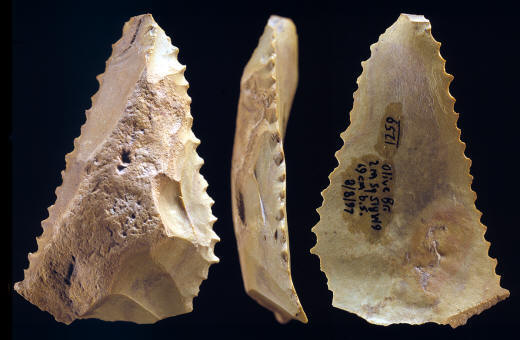|
Several examples of awls were also found on the Olive Branch site. They
were formed by pressure flaking one end of the flake into a sturdy projecting point
that could be used for piercing through soft materials like wood, hide,
antler, bone or shell. Gramly writes that, "Judging by their large size
and thickness, these implements were hand-held and used with
considerable force on wood and other yielding substances."
|
|
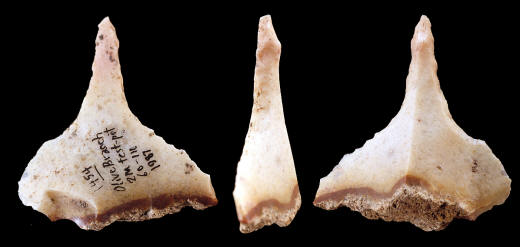
CLICK ON PICTURE FOR LARGER IMAGE
AWL
OLIVE
BRANCH SITE
ALEXANDER
COUNTY, ILLINOIS
EARLY ARCHAIC
PRIVATE
COLLECTION
Several
examples of awls were also found at Olive Branch. They were formed
by pressure flaking one end of the flake into a sturdy projecting point
that could be used for piercing through soft materials like wood,
hide, antler, bone or shell. Gramly writes that, "Judging by their
large size and thickness, these implements were hand-held and used
with considerable force on wood and other yielding substances." The
example illustrated here is made of Kaolin chert. |
|
|
Denticulates are yet another
form of blade tool that was found on the Olive Branch site. They stand
out and usually catch the eye because of their large serrated edges. The
sharp saw-like edges are thought to have been used for cutting or sawing
soft materials, like wood. The gaps between the teeth vary from 1 mm to
8 mm. Dalton people also liked to put large sharp toothed edges on some
of their projectile points. |
|
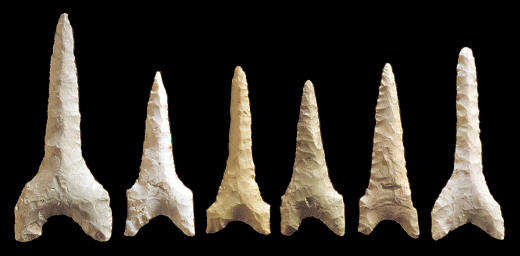
CLICK ON PICTURE FOR LARGER IMAGE
DALTON "DRILLS"
OLIVE
BRANCH SITE
ALEXANDER
COUNTY, ILLINOIS
EARLY ARCHAIC
PRIVATE
COLLECTION
One of the more confusing Dalton tool types are the Dalton drills.
These are represented by concave based projectile points that have
been resharpened until they have an appearance of an awl or drill.
These have always been referred to as drills but the majority of
them never show any wear that would indicate they were ever used as
drills. So it's logical to assume that they are just extensively
resharpened projectile points. On-the-other-hand, there are
bifacially flaked examples, that were not made from projectile
points, that do seem to be purposely made for perforating or
drilling procedures. Microscopic analysis of the edges, to look for
any wear patterns, is the only sure way of determining whether any
particular "drill" may have been used as a projectile point or
drilling tool. The longest
"drill" found on the Olive Branch site measured 4 3/8 inches (11 cm)
long. |
|
|
One of the more confusing Dalton tool types are
the Dalton drills. These are represented by concave based projectile
points that have been resharpened until they have an appearance of an
awl or drill. These have always been referred to as drills but the
majority of them never show any wear that would indicate they were ever
used as drills. So it's logical to assume that they are just extensively
resharpened projectile points. On-the-other-hand, there are bifacially
flaked examples, that were not made from projectile points, that do seem
to be purposely made for perforating or drilling procedures. Microscopic
analysis of the edges, to look for any wear patterns, is the only sure
way of determining whether any particular "drill" may have been used as
a projectile point or drilling tool. |
|
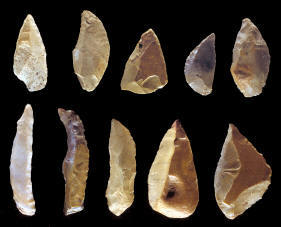 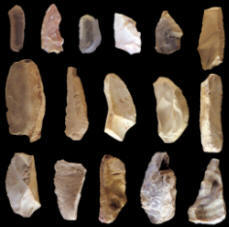
CLICK ON EACH PICTURE FOR LARGER IMAGE
DALTON SIDE-SCRAPERS
OLIVE
BRANCH SITE
ALEXANDER
COUNTY, ILLINOIS
EARLY ARCHAIC
PRIVATE
COLLECTION
Side-scrapers have been found on Stone Age sites
around the world. Four different forms of side-scrapers have been
described from the Olive Branch site. The most common form are
side-scrapers with only one scraping edge. Another form has one
scraping edge with only slight use wear on the opposite edge. A
third form are side-scrappers that have two
working edges that converge to a point. The fourth type found on the
Olive Branch site are side-scrapers that have two working edges that are
parallel to each other. |
|
|
One of the most diagnostic stone tools made by Dalton people, besides
projectile points, are the adzes. They made them in large numbers and
hafted them onto short handles to cut wood. Gramly writes that
"Wood-working tools were abundant at the Olive Branch site, which is
hardly surprising for a central base camp located on the banks of
America's mightiest River (Mississippi)." Just as New Guinea tribesman
have been observed using their adzes for cutting down trees and making
canoes, they were probably used just as efficiently by Dalton craftsmen.
Gramly describes three different types of bifacially flaked adzes from
the Olive Branch site. One is a pointed-end-adze that is the rarest of
the three. They have a working bit on one end and taper to a point on
the opposite end. Gramly comments that "Such a delicate implement may
have been useful for carving wooden tableware, stools and other small
personal items." The other two types are represented by single bladed
adzes and double bladed adzes that have a blade on each end. The size of
these adzes were limited by the locally available Bailey chert nodules.
These adzes range in size from 1 3/8 inches (3.5 cm) to 4 1/4 (10.7 cm)
long. |
|
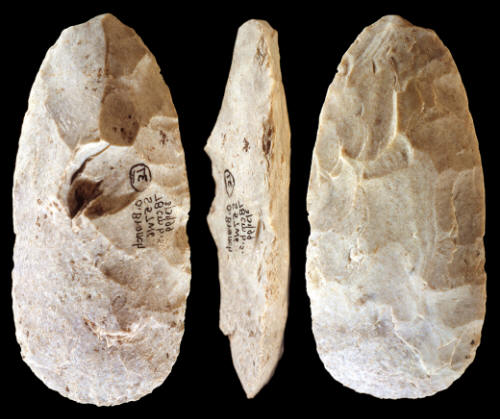
CLICK ON PICTURE TO VIEW 9 MORE EXAMPLES
DALTON ADZE
OLIVE
BRANCH SITE
ALEXANDER
COUNTY, ILLINOIS
EARLY ARCHAIC
PRIVATE
COLLECTION
One of the most diagnostic stone tools made by Dalton people,
besides projectile points, are the adzes. They made them in large
numbers and hafted them onto short handles to cut wood. Gramly
writes that "Wood-working tools were abundant at the Olive Branch
site, which is hardly surprising for a central base camp located on
the banks of America's mightiest River (Mississippi)." Just as New
Guinea tribesman have been observed using their adzes for cutting
down trees and making canoes, they were probably used just as
efficiently by Dalton craftsmen. Gramly describes three different
types of bifacially flaked adzes from the Olive Branch site. One is
a pointed-end-adze that is the rarest of the three. They have a
working bit on one end and taper to a point on the opposite end.
Gramly comments that "Such a delicate implement may have been useful
for carving wooden tableware, stools and other small personal
items." The other two types are represented by single bladed
examples and double bladed adzes that have a blade on each end. The
size of these adzes were limited by the locally available Bailey
chert nodules. These adzes range in size from 1 3/8 inches (3.5 cm)
to 4 1/4 (10.7 cm) long.
The adze illustrated here has a single blade. It was found at
a depth of 30 3/8 inches (78 cm) below the surface and it's made of
Mill Creek chert. |
|
|
A common tool form that is found on practically all Stone Age sites, in
one form or another, are sandstone abraders. The Olive Branch site
produced an abundance of abraders in every sector of the excavation.
Although the Dalton people at Olive Branch had locally available
Thebes-Sandstone they chose instead to use a coarse hematitc variety
that is found farther to the south along the Mississippi River near
Wickliffe, Kentucky. The abraders from Olive Branch have grooves cut
across their surface in varying widths from 1 to 15 mm wide and they
vary in depth from 1 to 12 mm deep. Abraders are tools that were used
for smoothing surfaces. They were probably used more extensively on wood
than anything else. A fine grain sandstone may also have served, in
flintknapping, to dull an edge of a preform to prepare a platform for
striking off a reduction flake. |
|
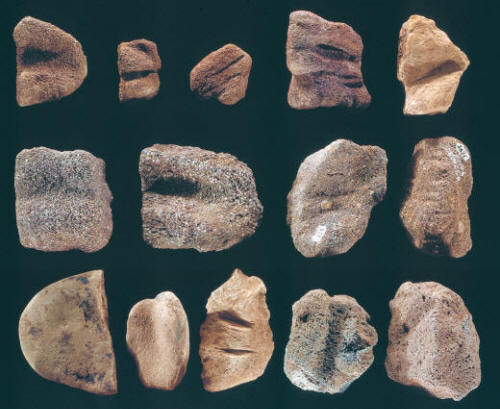
CLICK ON PICTURE FOR LARGER IMAGE
DALTON ABRADERS
OLIVE
BRANCH SITE
ALEXANDER
COUNTY, ILLINOIS
EARLY ARCHAIC
PRIVATE
COLLECTION
Abraders are common tool forms that are found on practically all
Stone Age sites, in one form or another. The Olive Branch site
produced an abundance of abraders in every sector of the excavation.
Although the Dalton people at Olive Branch had locally available
Thebes-Sandstone they chose instead to use a coarse hematitc variety
that is found farther to the south along the Mississippi River near
Wickliffe, Kentucky. The abraders from Olive Branch have grooves cut
across their surface in varying widths from 1 to 15 mm wide and they
vary in depth from 1 to 12 mm deep. Abraders are tools that were
used for smoothing surfaces. They were probably used more
extensively on wood than anything else. A fine grain sandstone may
also have served, in flintknapping, to dull an edge of a preform to
prepare a platform for striking off a reduction flake. |
|
|
The Olive Branch site produced some of the earliest examples of anvil
stones. Anvil stones are large stones, some quite heavy, that have a
pitted surface from pounding. Some examples also show signs of other
kinds of surface abrasions. The most obvious use for these tools were as
platforms upon which nuts were cracked. They may also have been used to
prepare food in other ways, such as pulverizing seeds. |
|
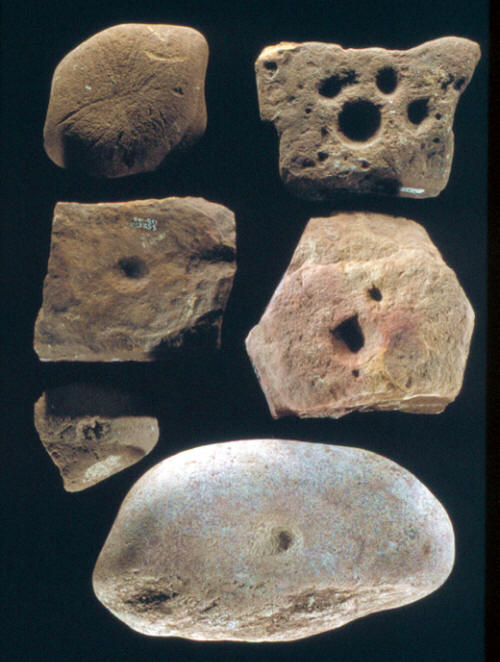
CLICK ON PICTURE FOR LARGER IMAGE
DALTON ANVIL STONES
OLIVE
BRANCH SITE
ALEXANDER
COUNTY, ILLINOIS
EARLY ARCHAIC
PRIVATE
COLLECTION
The Olive Branch site produced some of the earliest examples of
anvil stones. Anvil stones are large stones, some quite heavy, that
have a pitted surface from pounding. Some examples also show signs
of other kinds of surface abrasions. The most obvious use for these
tools were as platforms upon which nuts were cracked. They may also
have been used to prepare food in other ways, such as pulverizing
seeds. |
|
|
Another tool form are the hammer stones. Only about 43 examples were
discovered at Olive Branch so they are considered fairly rare on this
site. Hammer stones were used just as the name implies, for striking off
flakes for stone tool manufacturing or they may also have been used to
break open seeds or nuts. Since there were so few hammer stones found at
Olive Branch, their main tool for percussion flaking was probably made
of an organic material like antler, bone or wood. |
|
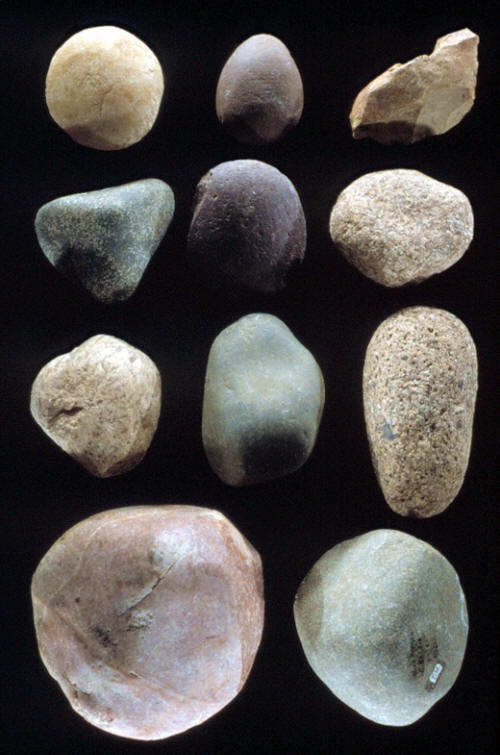
CLICK ON PICTURE FOR LARGER IMAGE
DALTON HAMMER STONES
OLIVE
BRANCH SITE
ALEXANDER
COUNTY, ILLINOIS
EARLY ARCHAIC
PRIVATE
COLLECTION
These 11 hammer stones were discovered on the Olive Branch site.
Only 43 were found altogether so they are considered fairly rare
when compared to the numbers of other artifacts found. Hammer stones
were used just as the name implies, for striking off flakes for
stone tool manufacturing or they may also have been used to break
open seeds and nuts. Since there were so few hammer stones found at
Olive Branch, their main tool for percussion flaking was probably
made of an organic material like antler, bone or wood. |
|
|
Dalton people produced a wide variety of tools
that range from the very simple to the most complicated and skillfully
crafted. Some of their tool forms, like utilized flakes and
side-scrapers, had been in use, up to that time, ever since the
beginning of human development. The technology that produced the flakes
that were used to make the tools at Olive Branch may be different. But
the flakes still cut and scrape in the same way as those used during the
Old World Paleolithic Period hundreds of thousands of years ago. |
|
"REFERENCES"
1983, Morse, Dan F.
and Morse, Phyllis A., "Archaeology Of The Central Mississippi Valley,"
p. 73.
2002, Gramly, Richard Michael
"Olive Branch: A Very Early Archaic Site On The Mississippi River," p.
116.
|
|
RECENT LISTINGS HOME
ORDERING |
